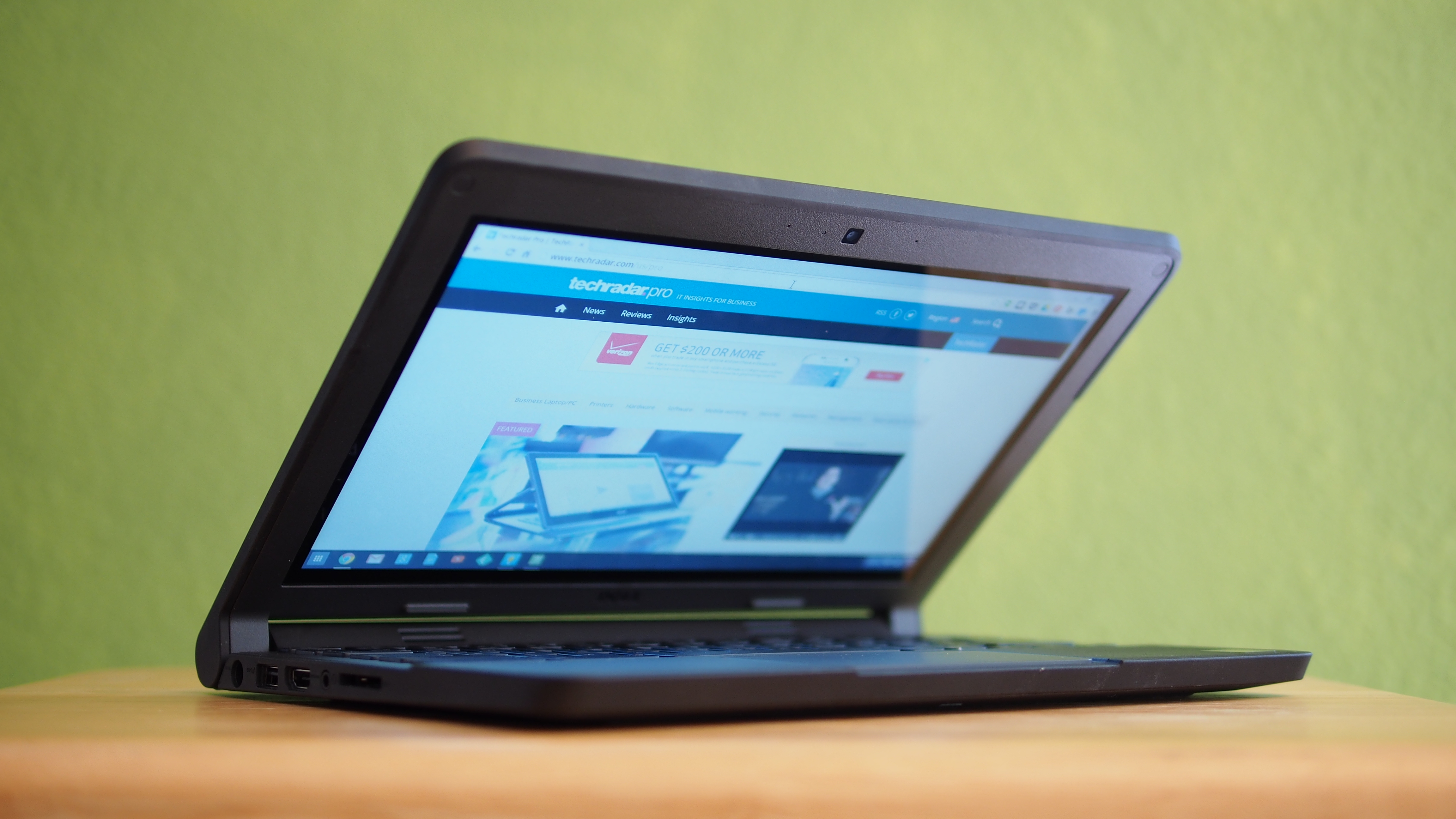TechRadar Verdict
Dell packed some of the best features from its more expensive business notebooks into a compact design that's built to survive daily use in the education market.
Pros
- +
Rugged, military tested design
- +
Loud speakers
- +
180-degree barrel hinge
Cons
- -
Touchscreen not standard
- -
Small keyboard
- -
Large footprint for screen size
Why you can trust TechRadar
Specifically built to withstand the abuses inherent to an education environment, this year's Dell Chromebook 11 features a solid build housed in a boring design. The Chromebook 11 ($249, £170, AU$320) looks more like a business laptop with its understated looks, but Dell claims its purpose-built design means that this notebook should survive drops, water spills, dirt and dust and most things that the harsh academic K-12 environment throws at it.
Direct competitors in this rugged space include Acer's 11-inch Chromebook C740 ($249, £170, AU$320) and 15-inch Chromebook C910 ($299, £200, AU$385). Dell's new Latitude 11 ($299, £194, AU$386), which swaps Chrome OS for Windows in a similar form factor, is also an excellent rugged candidate for the education segment.
Those who don't need the rugged design and choose form over durability will find the Samsung Chromebook 2 ($249, £154, AU$282), Toshiba Chromebook ($279, £167, AU$309), and Lenovo N20p ($329, £210, AU$380) to be solid choices. The recently announced all-metal Asus Flip ($249, £167, AU$327) comes with a hybrid 360-degree hinge, allowing it to transform into various form factors, including use as a tablet.
Home users who may not have budget constraints can find more powerful systems elsewhere. The 11-inch MacBook Air ($899, £605, AU$1,155) is a compelling choice given its small footprint, solid aluminum construction, and portability. Apple bundles its free productivity software with OS X, and unlike Chrome OS, the Air can be used as a regular notebook without requiring a constant tether to the internet.
Design
Unlike Asus, which is trying to reinvent the Chromebook category with its 360-degree hinge on the Flip, Dell is taking a more measured approach in creating a durable product that will survive daily student use and abuse.
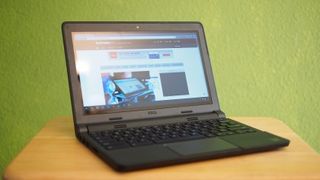
Because of the rugged construction, Dell's Chromebook 11 ends up slightly larger and heavier than the competition. Compared to Toshiba's Chromebook 2, a device with a larger 13.3-inch panel that measures 12.6 x 8.4 x 0.76 inches (32.0 x 21.3 x 1.9cm), the Chromebook 11 occupies almost the same footprint at 11.69 x 8.57 x 0.83 inches (29.7 x 21.8 x 2.1cm). Acer's C740 with a similar 11.6-inch display is slightly more compact than the Dell model at 11.3 x 8 x 0.79 inches (28.7 x 20.3 x 2.0cm).
With a touchscreen, the 2.91-pound (1.32kg) Dell Chromebook 11 is heavier than the Acer C740's 2.87-pound (1.30kg) weight. Without a touchscreen, Dell's model is only 2.74 pounds (1.24kg). The Chromebook 11's weight is about on par with the 11-inch category, and is still light enough for students to carry around all day.

What sets the Dell Chromebook 11 apart from others on the market is its rugged design. Dell claims that its new Chromebook 11 passes US Military Standard testing for durability, dirt, dust, pressure, temperature, humidity, shock and vibration "so it can handle student life."
To meet those durability claims, Dell cloaks its Chromebook 11 in a solid, matte black plastic case, a design choice that hides scratches, dirt and fingerprints well. A rubber bumper along the edges of the Chromebook 11 helps shield the notebook in case it's dropped.
Acer's education-centric Chromebook offerings come with reinforced hinge designs and strengthened corners, but lack the full rubber bumpers and the sealed keyboard and trackpad of the Dell Chromebook 11.
On the Chromebook 11, the touchscreen is an optional upgrade, and it allows students another means to interact with the content on their Chromebook beyond the keyboard and trackpad.
Another feature that sets the Chromebook 11 apart from the competition is the reinforced barrel hinge. Not only does the barrel hinge allow the lid to be opened up to 180 degrees for better peer-to-peer collaboration, Dell says that it is also extremely sturdy. As students would often grab and carry the Chromebook by the lid, the barrel design helps to reduce stress and prevent the hinge from breaking.
The hinge also houses loud, forward-firing stereo speakers.
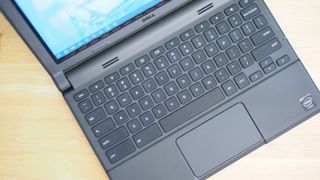
The non-backlit keyboard is surprisingly pleasant to use. With almost full-size keys - the keys are about 1/16 inches more narrow than the keys on a 15-inch MacBook Pro - typing is comfortable. The keys are extremely springy, but lack the key travel of a full-size laptop keyboard.
There is a dedicated row of standard Chrome shortcut keys on top of the keyboard. The trackpad on the Chromebook 11 is extremely responsive, and I found cursor tracking to be accurate.
Rugged durability
In addition to the reinforced barrel hinge, the Chromebook 11 comes with a waterproof keyboard and trackpad - features that are typically found on more expensive business laptops, like the Lenovo ThinkPad T450s ($881, £591, AU$1,131).
The waterproof keyboard means that the Chromebook 11 can be used in science labs and other hazardous education environments.
For those opting for a touchscreen model, the Corning Gorilla Glass NBT screen helps to protect the display from scratches.
The Chromebook 11 is available in two color options. Dell is selling the black version at $249 (£170, AU$320), with the blue version commanding a $10 (£7, AU$13) premium. Both versions start with 2GB of RAM and a 720p HD non-touch display.
Here's how the unit sent to TechRadar for review was configured.
Spec sheet
- Processor: 2.6GHz dual-core Intel Celeron Bay Trail-M N2840
- Graphics: Intel HD for Intel Celeron processors
- Memory: 4GB RAM (DDR3L, 1,600Mhz)
- Storage: 16GB SSD
- Screen: 11.6-inch HD, 1366 x 768 touchscreen
- Camera: 720p webcam
- Wireless: Bluetooth 4.0; 802.11ac (B/G/N), dual-band Wi-Fi
- Ports: HDMI 1.4, 1x USB 3.0, 1x USB 2.0, memory card reader, secondary memory card reader with lock, 3.5mm combo jack
- Battery: Three-cell
- OS: Chrome OS
If you can afford the $70 (£47, AU$90) premium, the touchscreen version of the Chromebook 11 starts at $329 (£210, AU$380) and provides a future-proof computing experience, especially if you're looking to hang on to the Chromebook for several years. Google is starting to port Android apps to Chrome OS, and a touchscreen makes that experience better than using a keyboard and trackpad.
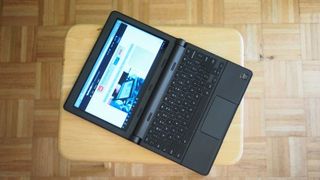
Additionally, a touchscreen can also help increase classroom collaboration. By laying the screen flat with the barrel hinge, students can tap on the touchscreen to share, collaborate, and interact with their content.
Performance
While the dual-core Celeron Bay Trail-M processor doesn't quite have the raw performance of the Intel Broadwell chip inside this year's Google Chromebook Pixel ($999, £799, AU$1,277), performance on the Dell Chromebook 11 is extremely smooth.
Given that most computing activity on a Chromebook will be done through the cloud rather than on the device - and that most Chromebook users won't be running heavy video editing programs anyways - "downgrading" to an Atom-based processor on the Dell model brings a lot of value for the performance.
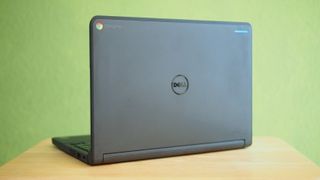
In real-world use, performance of the Chromebook 11 is similar to the Toshiba Chromebook 2. Both models share the same processor, RAM and screen resolution, but the Toshiba model comes with a larger 13-inch display.
I had about 15 tabs running in three different browser windows without any slow downs on the Chromebook 11. The Chromebook 11 is fast, responsive, and exhibited no delays.
The Intel Celeron chipset's performance seems better than the ARM CPU on the competing Acer Chromebook 13, which runs on Nvidia's Tegra K1 processor, and exhibited slightly diminished performance when tested by TechRadar.
Multimedia
Unfortunately, lacking the in-plane switching (IPS) screen technology of the Toshiba Chromebook 2's display, the Chromebook 11 has narrower viewing angles. The 180-degree hinge design mitigates this somewhat as it allows students to still have peer-to-peer collaboration when the screen is laid flat.
In my testing, I found that even though the screen is adequately bright indoors with a 200-nit rating, I struggled with the display outdoors as the screen was too dim, even at full brightness.
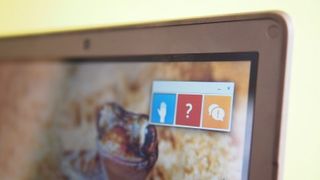
Surprisingly, audio produced by the stereo speakers came out loud and clear. In fact, at the loudest volume, audio produced by the Chromebook 11 could fill a small room.
When watching YouTube review videos, instructional TED Talk videos, and streaming music on Pandora, I preferred to keep the volume between 50% and 80%. I found that there is slight distortion at volumes higher than 80%, and at that level the audio lacked fullness.
Battery life
With a stated battery life of 10 hours, the Chromebook delivers an all-day computing experience. For classroom use, this means that teachers won't need to recharge Chromebooks between classes or in the middle of lessons, and students won't need to find power outlets when using the Chromebook 11.
In real-world use, with screen brightness set to around 60%, the Chromebook 11 lasted for just over eight hours on a single charge. In my testing, I surfed the web, managed my emails, watched a few marketing videos on YouTube, edited documents in Google Docs and Google Sheets, checked the news on Feedly and performed Google search in the Chrome browser.
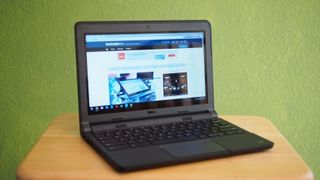
Eight hours is enough to get through a full school day, but students who carry their own Chromebook 11 likely will need to charge the Chromebook at some point during the day if they intend on using the netbook after-school for homework or other extracurricular functions.
Collaboration and communication
Dell has created a useful way to use technology to foster classroom engagement. The Dell activity light is a tool that encourages participation and communication.
For students who may be too timid to raise their hands or speak up in class, the activity light alerts instructors when a student wants to join a discussion or has a question. Students can tap or click the appropriate icon on the accompanying app on the Chromebook, and a corresponding light will appear on the lid to alert the instructor.
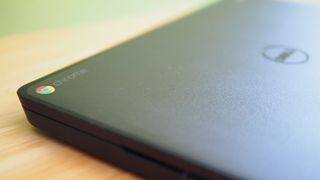
A blue light means the student wants to participate. A red light indicates that a student has a question. And finally, a yellow light alerts the instructor that the student may need more time or may not have understood the materials presented.
Chromebook management
To manage the Chromebook 11, Dell offers an easy enterprise mobility management solution through its KACE program. School IT administrators can use the Dell KACE K1000 Systems Management Appliance as a comprehensive systems management solution to inventory Chromebooks.
Dell also sells a $1,899 (£1,280, AU$2,450) mobile computing cart that can store up to 30 devices at a single time. The cart, when used inside a classroom environment, allows teachers to securely lock up the Chromebooks for safe storage. Additionally, the cart is also a charging hub, allowing educators to quickly charge up to 30 Chromebook 11 laptops overnight.

The value of running Chrome OS on the Chromebook 11 is that it requires very little maintenance. Unlike using Windows systems that require constant OS updates, antivirus software, and a powerful CPU and GPU to handle computing tasks, the Chromebook 11 is a physical device that connects to the cloud to do heavy lifting.
Students just need to sign into the Chromebook 11 with their Google ID and Google will keep Chrome OS constantly updated in the background. As users are mainly running web apps, not much computing power is needed as long as the school has a robust wireless connection.
As one of the few Chromebooks specifically marketed for education, the Dell Chromebook 11 is an excellent option for students who need a durable computing experience that will last them for years. Solid construction, beautiful touchscreen display, and smooth performance make this year's Dell Chromebook 11 a winner.
We liked
There is plenty to love with Dell's vision for Chrome computing in the classroom. The Chromebook 11's rugged design, durable construction, loud speakers, and excellent keyboard experience (for the price point) make this a solid choice for students.
Add in the optional touchscreen, and you'll likely be able to keep the Chromebook 11 future-proof for years to come.
We disliked
Even though the typing experience on the $249 (£170, AU$320) Chromebook 11 is excellent for the value, the keys are 1/16 inches smaller than keys on a MacBook Pro, and Dell could have made better use of the Chromebook 11's thickness by giving the keys more travel when pressed.
Final verdict
Don't let the understated aesthetics of the Chromebook 11 fool you. Dell packed in features that are typically reserved for more expensive business notebooks into its Chromebook 11 in an effort to create a durable product for the education market. In the Chromebook 11, you'll find a 180-degree reinforced hinge, rugged design, sealed keyboard and trackpad, and a great typing experience inside a portable package. In addition to using the Chromebook for school, students will appreciate the loud stereo speakers for multimedia and entertainment.

Until Dawn's movie adaptation won't follow the same story — here's why I think that's a good thing

I’ve found a new AI podcast creator, and it leaves Google’s NotebookLM in the dust

Severance season 2 review: Apple TV Plus' superb mystery thriller gets back to work with a bigger, bolder, and more brilliantly bizarre entry
